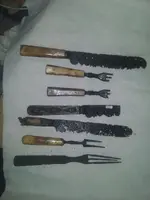Fossils
Full Member
- #1
Thread Owner
Hi all. Have any of you folks (particularly bottle diggers) dug up/preserved wooden artifacts?
I was digging at a bottle pit today and found a small Victorian-era toy boat made of wood. It isn't badly rotted, but parts of the wood seem kind of soft. I haven't cleaned it yet, so it's still caked with dirt.
How would one go about cleaning and/or protecting dug wood objects like this? Thanks!
I was digging at a bottle pit today and found a small Victorian-era toy boat made of wood. It isn't badly rotted, but parts of the wood seem kind of soft. I haven't cleaned it yet, so it's still caked with dirt.
How would one go about cleaning and/or protecting dug wood objects like this? Thanks!




